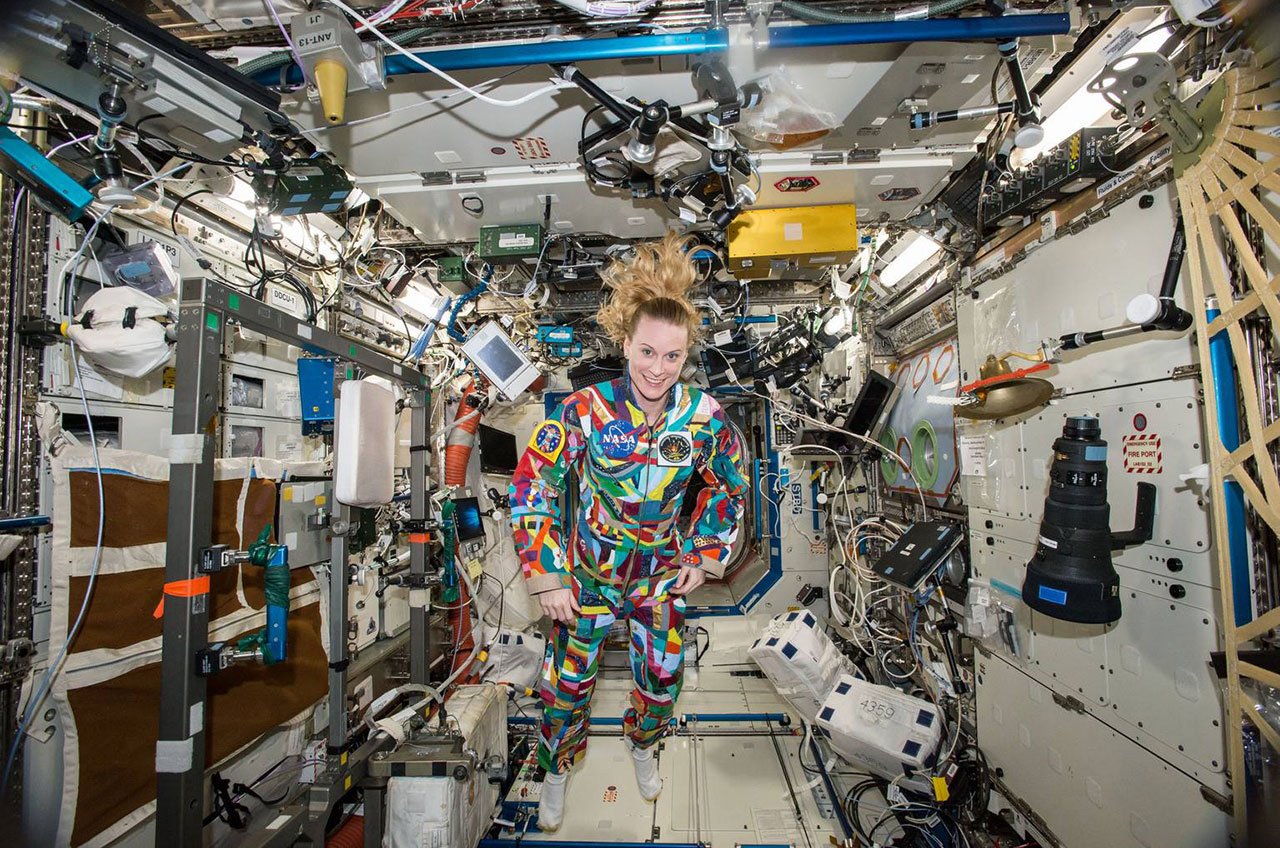Space Station Astronaut Wears Flight Suit Painted by Pediatric Cancer Patients

HOUSTON — An astronaut on board the International Space Station debuted a colorful flight suit on Friday (Sept. 16) as part of an effort to raise awareness about childhood cancer and the benefits of pairing art with medicine.
NASA flight engineer Kate Rubins revealed "COURAGE," a hand-painted flight suit created by the pediatric patients recovering at the University of Texas MD Anderson Cancer Center in Houston. The unique garment was produced by The Space Suit Art Project, a collaboration between MD Anderson, NASA Johnson Space Center and ILC Dover, a company that develops NASA spacesuits.
"This project has really inspired me," said Rubins during a live video conversation with MD Anderson pediatric cancer patients and representatives of The Space Suit Art Project on Friday. "It was an amazing opportunity to get a chance to paint with you guys. I remember this suit when it was just a blank canvas and all of you guys painted on it." [Evolution of the Spacesuit in Pictures (Space Tech Gallery)]
Before she launched to the station in July, Rubins joined former-astronaut-turned-artist Nicole Stott and other NASA representatives who lent their time and artistic talents to create "COURAGE" and mentor the young cancer patients at MD Anderson.
"We here are all experiencing our first real art exhibit on the space station," Stott told Rubins from Mission Control.
Born out of the hospital's Arts in Medicine Program, which helps patients cope with cancer treatment through art, The Space Suit Art Project inspired the leaders within NASA's space station program to support the effort with help from astronauts, scientists and engineers. The agency provided the patterns for the suits and collaborated with ILC Dover to assemble the garments.
"COURAGE" was delivered to the space station on July 20 on SpaceX's ninth Dragon cargo spacecraft to supply the orbiting laboratory.
Breaking space news, the latest updates on rocket launches, skywatching events and more!
"When we were unpacking all the cargo, I said let us look out for this spacesuit. This is so important and all of these kids have made some beautiful art," said Rubins.
In addition to "COURAGE," which was created by having cancer patients paint their designs directly onto the flight suit's fabric, The Space Suit Art Project has also produced wearable, replica spacesuits based on the equipment worn by astronauts outside the space station.
The project's first spacesuit, named "HOPE," was stitched together from more than 600 painted art pieces created by patients, families and staff at MD Anderson. It is intended to represent the hope patients and families have as they go through treatment.
Stott and Ian Cion, the director of MD Anderson's Arts in Medicine program, embarked Aug. 31 on a 12-day journey to pediatric cancer centers in Cologne, Germany; Moscow, Russia and Tokyo, Japan to provide young patients with a chance to contribute to the "UNITY" spacesuit.The creation a second replica spacesuit is now underway as an international collaboration with children's hospitals around the world. "UNITY" will symbolize the global issues surrounding childhood cancers, with a goal to unite others, help spread awareness about childhood cancers and offer hope and courage to cancer patients around the globe.
Stott and Cion were in Houston on Friday to be in Mission Control for the live event with Rubins on the space station.
"COURAGE," which was painted by MD Anderson patients, many of whom were in isolation during their treatment, is meant to demonstrate the courage it takes to be isolated from family and friends during long periods of time.
According to MD Anderson, research shows that creative arts therapy can benefit patients' mental and behavioral health. The hospital uses art activities like The Space Suit Art Project to give patients a sense of control and purpose, make them more comfortable in the hospital environment and help build a sense of community among patients and families.
"I can tell you that wonderful healing things are coming from these art projects with the people working them," said Stott. "I know for myself, like Kate said, the inspiration that comes from this is 'gi-normous,' in the words of my son."
"As September is childhood cancer awareness month, this couldn't have happened at a better time," she said.
On average, one in 285 children in the U.S. are diagnosed with cancer before the age of 20.
"COURAGE," once returned to Earth, is scheduled to go on display at Space Center Houston, the visitor center for NASA's Johnson Space Center, in January 2017.
See The Space Suit Art Project's first replica spacesuit, "HOPE," at collectSPACE.com.
Follow collectSPACE.com on Facebook and on Twitter at @collectSPACE. Copyright 2016 collectSPACE.com. All rights reserved.

Robert Pearlman is a space historian, journalist and the founder and editor of collectSPACE.com, a daily news publication and community devoted to space history with a particular focus on how and where space exploration intersects with pop culture. Pearlman is also a contributing writer for Space.com and co-author of "Space Stations: The Art, Science, and Reality of Working in Space” published by Smithsonian Books in 2018.
In 2009, he was inducted into the U.S. Space Camp Hall of Fame in Huntsville, Alabama. In 2021, he was honored by the American Astronautical Society with the Ordway Award for Sustained Excellence in Spaceflight History. In 2023, the National Space Club Florida Committee recognized Pearlman with the Kolcum News and Communications Award for excellence in telling the space story along the Space Coast and throughout the world.


